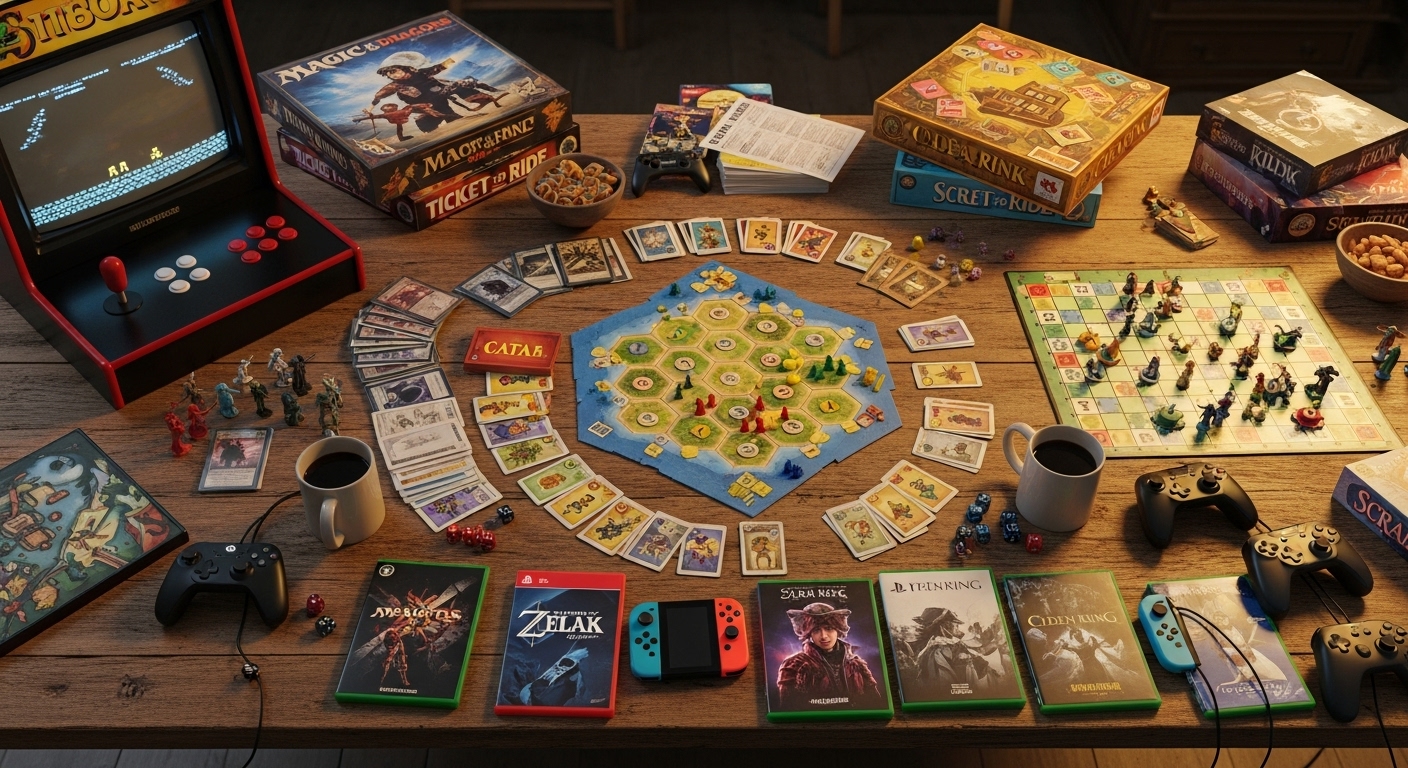Introduction: Gaming’s Global Impact and Cultural Significance
Gaming, once a niche hobby enjoyed by a select few, has now evolved into one of the most influential forms of entertainment worldwide. Today, the gaming industry is a multi-billion-dollar behemoth, surpassing the film and music industries combined. Whether it’s mobile gaming on smartphones, competitive eSports tournaments, or the expansive worlds offered by consoles and PCs, gaming has touched nearly every aspect of modern life.
From simple pixelated arcade games to hyper-realistic, expansive open-world experiences, video games have continuously pushed the boundaries of technology, storytelling, and interactivity. The industry has not only revolutionized entertainment but has also impacted social interaction, education, and even mental health. The development of gaming technologies has led to immersive experiences that were once unimaginable, creating new avenues for creativity and global connection.
This blog post will explore the journey of gaming, from its humble beginnings to its current state, as well as what the future holds for the world of interactive entertainment.
The Early Beginnings: From Arcade Machines to Home Consoles
The history of video games dates back to the 1950s and 1960s when early computer scientists began experimenting with interactive entertainment. However, the first commercially successful video game arrived in 1972 in the form of Pong, created by Atari. Pong was a simple simulation of table tennis, but its impact was immediate. It drew crowds to arcade halls and marked the beginning of a new form of entertainment—one that would captivate generations to come.
Following the success of Pong, arcade gaming flourished in the late 1970s and early 1980s. Iconic games like Space Invaders (1978), Pac-Man (1980), and Donkey Kong (1981) not only defined the arcade experience but also introduced a new kind of social interaction. Arcades became social hubs, where friends gathered to compete for high scores and engage in friendly rivalries. These games, though primitive by today’s standards, laid the groundwork for the gaming industry as we know it.
At the same time, the idea of gaming at home began to take shape. In 1977, Atari released the 2600, the first successful home gaming console, allowing people to play arcade-style games in the comfort of their own homes. The success of the Atari 2600 and the subsequent release of home consoles like the Nintendo Entertainment System (NES) in the 1980s marked a turning point in the gaming world, making video games accessible to everyone, not just those who frequented arcades.
The Golden Age of Consoles: Entering the World of Home Gaming
The 1980s and 1990s were a pivotal time for gaming. The release of the NES in 1985 revolutionized home gaming by offering a variety of games with more complex mechanics and better graphics than ever before. The NES introduced iconic titles like Super Mario Bros., The Legend of Zelda, and Metroid, all of which became foundational franchises in the gaming world. The console’s success was a turning point for gaming, proving that there was a significant market for video games outside of the arcade scene.
The 16-bit era brought even more advancements in gaming technology. The Sega Genesis and the Super Nintendo Entertainment System (SNES) introduced games with more colorful and detailed graphics, allowing for a wider range of creative possibilities. Titles like Sonic the Hedgehog, Super Mario World, and The Legend of Zelda: A Link to the Past defined the generation, offering players deeper gameplay experiences and more complex worlds.
As the technology progressed, so too did the ambition of game developers. The focus shifted from arcade-style games to immersive, narrative-driven experiences. With the introduction of Final Fantasy VII (1997) on the Sony PlayStation, role-playing games (RPGs) began to gain mainstream popularity, offering players complex storylines and character development that rivaled movies and books. The era of 3D gaming was now on the horizon.
The 3D Revolution: Entering a New Dimension
The late 1990s and early 2000s were a transformative period for the gaming industry, marked by the shift from 2D to 3D graphics. The Sony PlayStation, Nintendo 64, and Sega Dreamcast ushered in a new era of gaming, where the limitations of earlier consoles were replaced with expansive 3D worlds and more complex gameplay mechanics.
One of the most significant milestones in 3D gaming was the release of Super Mario 64 in 1996. This game, which was exclusive to the Nintendo 64, introduced players to a fully 3D world where they could freely explore environments, jump, and interact with objects in ways that had never been possible before. Super Mario 64 set the standard for 3D platformers, and its success paved the way for other franchises to embrace the new technology.
In addition to the shift to 3D, the PlayStation and Nintendo 64 era saw the development of more expansive and detailed game worlds. The Legend of Zelda: Ocarina of Time (1998) for the N64 is widely regarded as one of the greatest games of all time, offering players an open world to explore, filled with puzzles, combat, and side quests. Metal Gear Solid (1998) and Tomb Raider (1996) were also instrumental in pushing the boundaries of 3D gameplay, introducing complex narratives and cinematic presentation that were previously reserved for movies.
The 3D revolution did more than just enhance visuals—it also changed the way players interacted with games. The development of new control schemes and camera systems allowed players to navigate more intricate environments, setting the stage for the expansive, open-world games of the future.
The Emergence of Online Gaming: A New Era of Connectivity
As gaming technology evolved, so too did the ways in which players could interact with each other. The late 1990s and early 2000s saw the rise of online multiplayer gaming, a revolution that would forever change the gaming landscape. The launch of Xbox Live in 2002 was a major milestone, as it allowed Xbox users to connect to the internet and compete with players from around the world.
Games like Halo 2 (2004) and Counter-Strike (1999) became immensely popular for their online multiplayer modes, where players could battle in fast-paced, team-based competitions. For the first time, gaming became a truly global experience, with players from different continents able to connect and compete in real-time.
In addition to competitive gaming, online role-playing games (MMORPGs) such as World of Warcraft (2004) introduced players to persistent, shared virtual worlds. These games allowed thousands of players to interact with each other in a single, interconnected universe, where they could form alliances, complete quests, and explore massive game worlds together. MMORPGs created a sense of community within gaming, allowing players to build relationships, collaborate on in-game objectives, and even participate in large-scale virtual economies.
The social aspect of online gaming also led to the rise of livestreaming platforms like Twitch, where gamers could broadcast their gameplay and interact with viewers in real-time. This shift towards a more social and connected gaming experience has only continued to grow, with online multiplayer games becoming a staple of modern gaming culture.
The Rise of Mobile Gaming: Bringing Games to Your Pocket
In the mid-2000s, a new wave of gaming emerged that would further broaden the appeal of video games: mobile gaming. With the advent of smartphones, particularly the release of the iPhone in 2007, gaming became something that could be enjoyed anywhere and at any time. Mobile games like Angry Birds (2009) and Candy Crush Saga (2012) became instant sensations, offering players quick and accessible gameplay that could be enjoyed in short bursts.
The success of mobile games brought new players into the gaming fold, expanding the gaming audience beyond traditional console and PC gamers. Mobile gaming also democratized game development, allowing smaller indie developers to reach a wide audience without the need for expensive production costs. Games like Flappy Bird (2013) and Crossy Road (2014) became viral hits, demonstrating that simple, addictive gameplay could achieve massive success.
Today, mobile gaming continues to thrive, with a wide variety of genres and experiences available to players. From casual puzzle games to complex strategy games and even MMORPGs, mobile gaming has become a major pillar of the gaming industry, contributing to its global reach and success.
The Advent of Virtual and Augmented Reality: The Next Frontier
As gaming technology continues to evolve, virtual reality (VR) and augmented reality (AR) have emerged as the next frontiers in interactive entertainment. VR, which immerses players in a completely digital world through a headset, has made significant strides in recent years. Devices like the Oculus Rift and PlayStation VR offer players the ability to experience games in ways that were previously unimaginable, with full 360-degree environments and motion-based controls.
VR has opened up new possibilities for gaming, allowing players to physically move through virtual spaces, interact with objects, and experience games in a more immersive way. While still in its early stages, VR gaming has already shown great potential, with titles like Beat Saber (2018) and Half-Life: Alyx (2020) gaining critical acclaim for their innovative use of the technology.
Augmented reality (AR), on the other hand, blends the digital and physical worlds, allowing players to interact with digital




